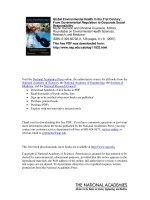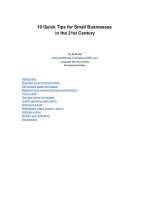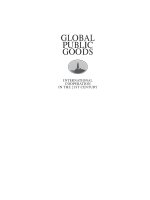Psychology applied to modern life adjustment in the 21st century, 11e chapter 3
Bạn đang xem bản rút gọn của tài liệu. Xem và tải ngay bản đầy đủ của tài liệu tại đây (1023.12 KB, 39 trang )
Chapter 3
Stress and Its Effects
The Nature of Stress
• Stress is “any circumstances that threaten or
are perceived to threaten one’s well-being and
thereby tax one’s coping abilities”.
•
Stress has several characteristics.
1. Stress is a common, everyday event.
•
Both major and minor problems can be
stressful.
•
Even daily “hassles” can have negative
effects on our well-being.
•
Stressful events have a cumulative
impact.
The Nature of Stress, continued
2. Stress is subjective. Not everyone feels the
same degree of stress from the same event.
• The difference may depend on how we
appraise events (see Figure 3.2).
• We first make a primary appraisal, or initial
evaluation of the relevance, level of threat,
and degree of stress the event brings.
• If viewed as stressful, we make a secondary
appraisal, or an evaluation of our ability to
cope.
Figure 3.2 Primary and secondary appraisal of stress. Primary appraisal is an initial evaluation of
whether an event is (1) irrelevant to you, (2) relevant, but not threatening, or (3) stressful. When you view an
event as stressful, you are likely to make a secondary appraisal, which is an evaluation of your coping
resources and options for dealing with the stress. (Based on Lazarus & Folkman, 1994)
The Nature of Stress, continued
3. Ambient stress – refers to chronic negative
conditions embedded in the environment.
• Certain types have been associated with
elevated stress hormones (see Figure 3.3).
4. Stress is influenced by culture.
• Culture affects which types of stress we
experience.
• Cultural change is a major source of stress
in most cultures.
Figure 3.3 Excessive noise and stress hormones. Evans, Hygge, and Bullinger (1995) compared
children from noisy areas near Munich International Airport with similar children from quiet neighborhoods in
Munich. They hound elevated levels of two hormones (epinephrine and norepinephrine) associated with
stress reactions in the children exposed to the high noise of the airport.
Adapted from Evans, G.W., Hygge, S., & Bullinger, M. (1995). Chronic noise and psychological stress.
Psychological Science, 6, 333-338. Copyright © 1995 Blackwell Publishers. Adapted by permission.
Major Sources of Stress, continued
•
There are three basic categories
1. Acute stressors – “threatening events that
have a relatively short duration and a clear
endpoint”.
2. Chronic stressors – “threatening events
that have a relatively long duration and no
readily apparent time limit”.
3. Anticipatory stressors – “upcoming or
future events that are perceived to be
threatening”.
• This stressor is unique to humans
Major Sources of Stress, continued
•
Other categories of stressors
1. Frustration – “occurs in any situation in
which the pursuit of some goal is thwarted”.
2. Internal conflict – “occurs when two or
more incompatible motivations or behavioral
impulses compete for expression”.
Major Sources of Stress, continued
– Internal conflicts come in three types (see
Fig. 3.4)
•
Approach – approach – must make a
choice between two attractive goals.
•
Avoidance – avoidance – must make a
choice between two unattractive goals.
•
Approach – avoidance – must choose
whether or not to pursue ONE goal, which
has both pros and cons.
– This conflict causes the greatest stress.
Figure 3.4 Types of conflict. Psychologists
have identified three basic types of conflict. In
approach-approach and avoidance-avoidance
conflicts, the person is torn between two goals. In
an approach-avoidance conflict, only one goal is
under consideration, but it has both positive and
negative aspects.
Major Sources of Stress, continued
3.Life changes – “any noticeable alterations in
one’s living circumstances that require
readjustment”.
– Holmes and Rahe (1967) believe both
positive and negative life changes are
associated with physical illness.
– They developed the Social Readjustment
Rating Scale (SRRS) to assess health risk
due to the accumulation of life changes (see
Figure 3.5).
Figure 3.5 Social Readjustment Rating Scale (SRRS). Devised by Holmes and Rahe (1967), this scale is designed to
measure the change-related stress in one’s life. The numbers on the right are supposed to reflect the average amount of
stress (readjustment) produced by each event. Respondents check off the events that have occurred to them recently and add
up the associated numbers to arrive at their stress scores.
Adapted from Holmes, T.H., & Rahe, R. (1967). The Social Readjustment Rating Scale. Journal of Psychosomatic
Research, 11, 213-218. Copyright © 1967 by Elsevier Science Publishing Co. Reprinted by permission.
Major Sources of Stress, continued
4.Pressure – “involves expectations or demands
that one behave in a certain way”.
– The two types of pressure below are important
and both are associated with many
psychological symptoms and problems (see
Fig. 3.6):
• Pressure to perform
• Pressure to conform
Figure 3.6 Pressure and psychological symptoms. A comparison of pressure and life change as
sources of stress suggests that pressure may be more strongly related to mental health than change is. In
one study, Weiten (1988) found a correlation of .59 between scores on the Pressure Inventory (PI) and
symptoms of psychological distress. In the same sample, the correlation between SRRS scores and
psychological symptoms was only .28.
Responding to Stress
•
•
Stress responses occur at three levels:
1. Emotional responses
2. Physiological responses
3. Behavioral responses
Emotional responses are usually negative
and fall into three categories:
1. Annoyance, anger, and rage
2. Apprehension, anxiety, and fear
3. Dejection, sadness, and grief
Responding to Stress, continued
– However, stress can prompt positive
emotional responses, which in turn
• Increase creativity, flexibility in problemsolving, and
• Enhance immune system functioning,
increase valuable social support, and
promote proactive coping.
Responding to Stress, continued
– Strong emotions may hamper or enhance
our ability to cope with stress, depending on
our level of arousal and the task complexity
(see Figure 3.9).
– The “inverted-U hypothesis” predicts that
• For low complexity tasks, a high level of
arousal is best;
• For medium complexity tasks, a medium
level of arousal is best; and
• For high complexity tasks, a low level of
arousal is best.
Figure 3.9 Arousal and performance. Graphs of the relationship between emotional arousal and task
performance tend to resemble an inverted U, as increased arousal is associated with improved performance
up to a point, after which higher arousal leads to poorer performance. The optimal level of arousal for a task
depends on the complexity of the task. On complex tasks, a relatively low level of arousal tends to be
optimal. On simple tasks, however, performance may peak at a much higher level of arousal.
Responding to Stress, continued
• Physiological responses.
– The fight-or-flight response - “a
physiological reaction to threat that
mobilizes an organism for attacking (fight)
or fleeing (flight) an enemy”.
– It occurs in the autonomic nervous
system (ANS), which “is made up of the
nerves that connect to the heart, blood
vessels, smooth muscles, and glands”.
Responding to Stress, continued
– The ANS is broken into two divisions (see
Fig. 3.10):
• Sympathetic division mobilizes energy
during emergencies, engages the fightor-flight response.
• Parasympathetic division conserves
energy, has calming effect on body.
– Unfortunately, the fight-flight
response is not well suited for coping
with modern threats.
Figure 3.10 The autonomic nervous system (ANS). The ANS is composed of the nerves that connect to
the heart, blood vessels, smooth muscles, and glands. The ANS is subdivided into the sympathetic division,
which mobilizes bodily resources in times of need, and the parasympathetic division, which conserves
bodily resources. Some of the key functions controlled by each division of the ANS are summarized in the
center of the diagram.
Responding to Stress, continued
– Hans Seyle’s general adaptation syndrome
is a “model of the body’s stress response,
consisting of three stages” (see Fig. 3.11).
1.Alarm phase – initial response to threat,
fight-or-flight response engages.
2.Resistance phase – if threat continues,
physiological changes stabilize, coping
begins.
3.Exhaustion phase – if the threat continues
too long, the body’s resources are
depleted, leading to physical exhaustion
and illness.
Figure 3.11 The general adaptation syndrome. According to Selye, the physiological response to stress
can be broken into three phases. During the first phase, the body mobilizes its resources for resistance after
a brief initial shock. In the second phase, resistance levels off and eventually begins to decline. If the third
phase of the general adaptation syndrome is reached, resistance is depleted, leading to health problems
and exhaustion.
Responding to Stress, continued
– Two brain-body pathways control our
physiological responses to stress (see Fig. 3.13):
1.The Catecholamine Pathway –
hypothalamus activates sympathetic system;
adrenal glands release catecholamines that
mobilize the body for action.
2.The Corticosteroid Pathway – hypothalamus
signals pituitary gland to secrete ACTH;
adrenal cortex to release corticosteroids that
increase energy.
Figure 3.13 Brain-body pathways in stress. In times of stress, the
brain sends signals along two pathways. The pathway through the
autonomic nervous system (shown in blue on the right) controls the
release of catecholamine hormones that help mobilize the body for
action. The pathway through the pituitary gland and the endocrine
system (shown in brown on the left) controls the release of
corticosteroid hormones that increase energy and ward off tissue
inflammation.









